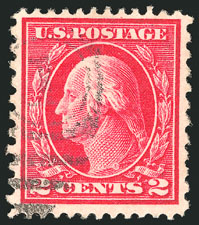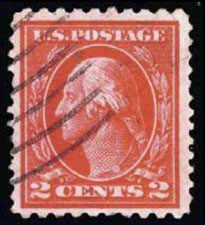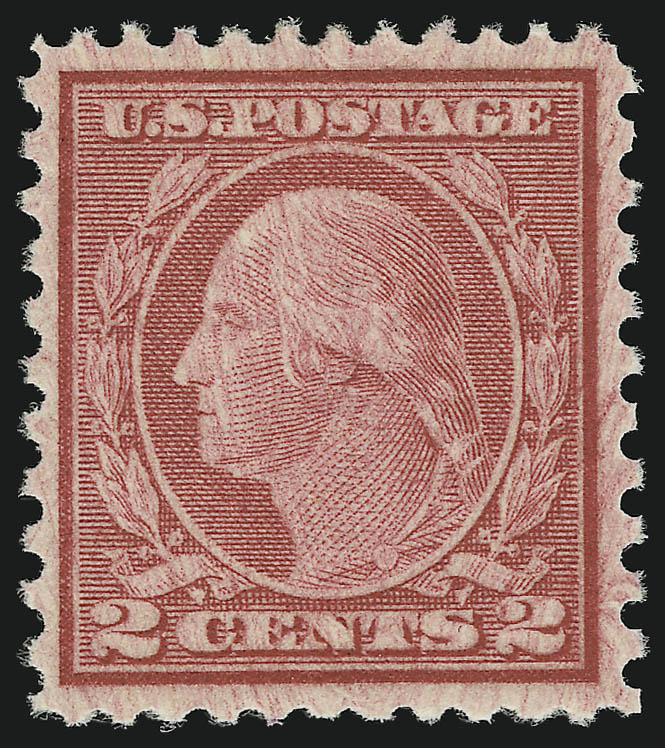
2¢ Washington Head
Flat Plate
Perf 11

Flat Plate - Perf 12x10
Seigel 877*

Flat Plate - Perf 10x12
Seigel Census*

Rotary - Perf 11 x 10
Type II*

Rotary - Perf 11 x 10
Type III
Type Check - If your stamp is perforated 11 x 10, you must determine if it is Type II or Type III . Don't waste a lot of time on this, it most certainly is type III, the type II is very, very rare.
| Number | Method of Printing | Type | Watermark | Perforation | Size of Design (mm) |
| 423B | Flat Plate | I | single-line | 424-12x10 | 19 x 22 |
| 423E | Flat Plate | I | single-line | 424-10x12 | 19 x 22 |
| 539 | Rotary Press | II | none | 11 x 10 | 19.5-20 x 22 (wider) |
| 540 | Rotary Press | III | none | 11 x 10 | 19x22.5-23 (taller) |
Caution
The 2¢ perf 12x10 and 10x12 are candidates for fakery, since they are relatively easy to manufacture from the imperforate srock, Number 409, or by reperforating two sides of the regular perf 10 stamp. However, they are so rare that a fake would hardly escape detection. The 2¢ single-line watermarked perf 10x12 is in fact the rarest U.S. stamp, with only one copy known. There is perhaps less debate over this stamp than the other unique U.S. stamp, the 24¢ Continental, which is assumed to be a Continental by virtue of its ribbing. As far as your editor knows, there is no dispute over the 2¢ perf 10x12. Compare this uniqueness with the 1¢ Z-Grill of which two copies are known, one of which was recently traded for the invert Jenny plate block which sold in a recent Siegel auction for nearly $3 million with buyer's premium.
*The 2¢ perf 12x10 stamp illustrated is from "The Chesapeake Collection of U.S. 1914 Compound Perforations", June 12, 2004, Robert A. Siegel Auction Galleries Sale 877. This is an important reference auction catalog and includes many of the ultra-rare 1914 compound perforated stamps, as well as an illustrated census of each.
*The 2¢ perf 10x12 stamp illustrated is from the Siegel Census Data. Note that the 1914 compound perforations are now considered regular production stamps, albeit exceptionally rare, and not error stamps. One can only guess how much the perf 10x12 two cent stamp will bring once it is fully realized that no U.S. collection can be considered complete without its presence.
* The type II rotary perf 11x10 is from "The Vineyard Collection of Outstanding United States Stamps",
October 8, 2004, Robert A. Siegel Auction Galleries Sale 883.
This stamp is also exceptionally rare in used condition, of which only 8 copies and a block of four are known. The toughest fakes are manufactured from the type II coils by adding fake gauge 11 perforations to the top and bottom, although the unwatermarked type II coil is a rare stamp in its own right and does not make a good candidate for such tomfoolery. The watermarked type II coil was of course printed on single-line watermarked paper, but a coil with a very weak watermark may avoid detection. It is also possible to manufacture a fake from the type III perf 11x10 stamp by removing an extra line in the ribbons (see type II or type III ). Other fakes are possible, none very likely to fool anyone with a perf gauge and a watermark tray. It is probably worth noting that some fakes were made by adding perforations to the perf 10 type II coil stamp, the 487, but since this was a vertical coil, the resulting stamp is perforated 10x11, a stamp which simply does not exist! If you should run across a two cent stamp perforated 10x11, that is 10 at top and bottom and 11 at the sides, you can rest assured the stamp is a fake. It is probably needless to say the type II rotary perf 11x10 should not be bought or sold without certification.
The type III perf 11x10 may be faked, but the only type III rotary stamp that can be used to manufacture it is the type III coil stamp. If perforations are added to the top and bottom edges, the stamp will be too small and at best will make a poor copy, worth less than the stamp from which it was made. If the stamp is perforated 11x10, is rotary (and almost certainly type III), you can rest assured it is genuine.
Washington Franklin Identifier - Home Page





